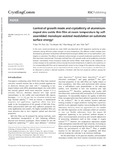Please use this identifier to cite or link to this item:
http://thuvienso.bvu.edu.vn/handle/TVDHBRVT/14122Full metadata record
| DC Field | Value | Language |
|---|---|---|
| dc.contributor.author | Vo, Thi Tien Thieu | - |
| dc.contributor.author | Ho, Yu-Hsuan | - |
| dc.contributor.author | Lin, Pao-Hung | - |
| dc.contributor.author | Tai, Yian | - |
| dc.date.accessioned | 2015-09-10T09:31:44Z | - |
| dc.date.available | 2015-09-10T09:31:44Z | - |
| dc.date.issued | 2013-08-08 | - |
| dc.identifier.uri | http://thuvienso.bvu.edu.vn/handle/TVDHBRVT/14122 | - |
| dc.description.abstract | In this work, aluminium-doped zinc oxide (AZO) was deposited via RF magnetron sputtering on glass substrates having different surface energies at room temperature. The different surface energies were developed by passivation of alkylsilane self-assembled monolayers (SAMs) with various hydrocarbon chain lengths on substrates. The effects of substrate surface energies on growth mode and crystallinity of AZO films have been characterized. This study confirmed that a film growth mode can be gradiently controlled between intermediate Stransi–Krastanov mode and Volmer–Weber mode based on the modulation of surface energies of the substrates without varying the process temperature. In addition, the crystallinity of the corresponding AZO films can be improved with respect to the change of the substrate surface energy. Thus, the electrical properties can be improved as well. Our study led to the conclusion that AZO films can be designed to achieve a desired crystalline orientation and electrical properties without varying the growth temperature. | - |
| dc.language.iso | en | vi |
| dc.publisher | CrystEngComm | vi |
| dc.relation.ispartofseries | CrystEngComm, 2013, 15, p. 6695–6701 | - |
| dc.subject | Aluminiumdoped | vi |
| dc.subject | Selfassembled | vi |
| dc.title | Control of growth mode and crystallinity of aluminiumdoped zinc oxide thin film at room temperature by selfassembled monolayer assisted modulation on substrate surface energy | vi |
| dc.type | Article | vi |
| Appears in Collections: | CNTP-KTHH - Xây dựng (Articles) | |
Files in This Item:
| File | Description | Size | Format | |
|---|---|---|---|---|
| Thi-Tien-Thieu-Vo.pdf | 857,11 kB | Adobe PDF |  Sign in to read |
Items in DSpace are protected by copyright, with all rights reserved, unless otherwise indicated.